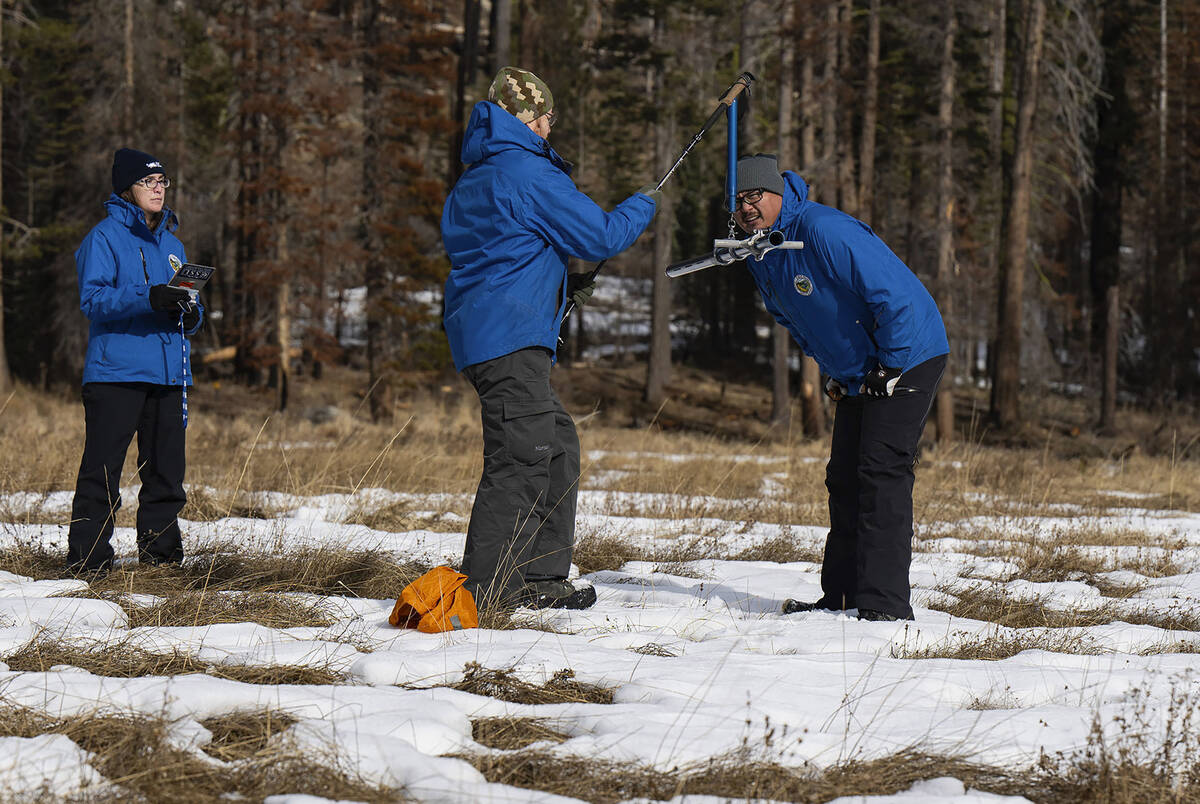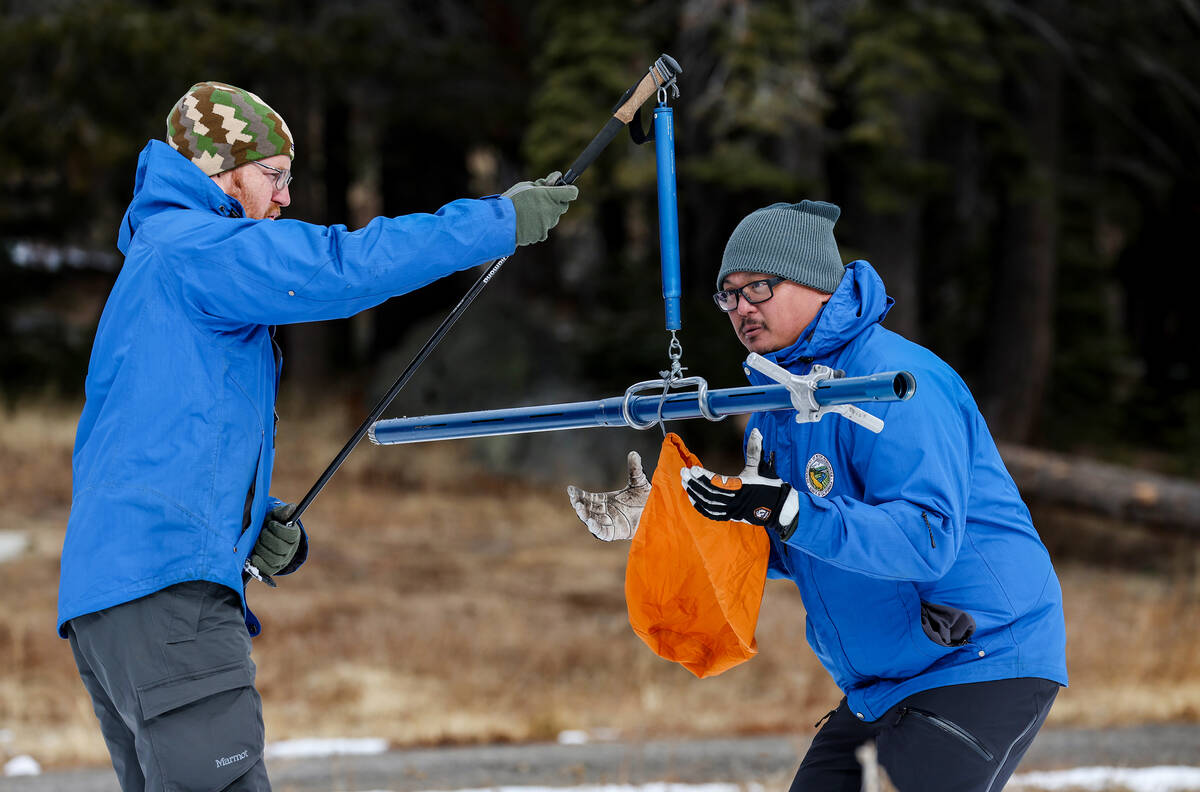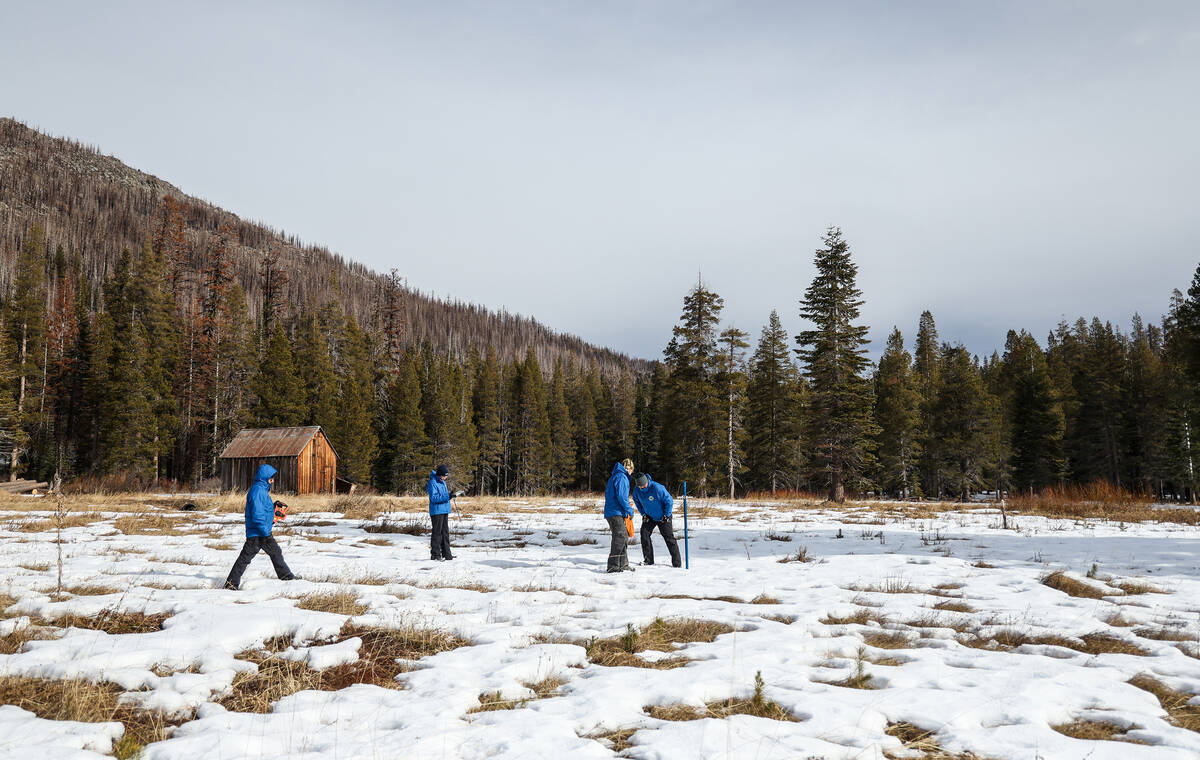California snowpack lowest in 10 years so far, Colorado slightly better
SAN JOSE, Calif. — California’s statewide Sierra Nevada snowpack — the source of nearly one-third of the state’s water supply — is at its lowest level in a decade, a major turnaround from last year when huge storms ended a three year-drought and buried ski resorts in massive amounts of snow.
On Tuesday, the snowpack was just 25 percent of its historical average for Jan. 2. The last time there was less snow at the beginning of a new year was on Jan. 2, 2014, when it stood at just 19 percent.
The lack of snow so far this year is due to fewer big storms hitting the state than normal, and when storms have come, they have been warmer, depositing snow mostly at higher elevations.
Impact for Nevada
A snow measurement that has an impact on the Las Vegas water supply is slightly better.
As of Tuesday, Colorado’s statewide snowpack remains far below the norm for this time of the year. Statewide, snowpack is at just 68 percent of what’s typical for January 2.
Of the eight different regions in western Colorado where spring runoff runs into the Lake Mead region, all were at 50 percent or lower for snowpack as of Jan. 2.
It was heavy spring snowmelt across most of the West last winter that allowed excess water to flow into Lake Powell and eventually rising Lake Mead more than 20 feet last year.
No cause for panic
The meager totals so far across California’s pre-eminent mountain range are not a cause to panic, experts say.
Not only are there three months left in the winter season, which typically ends in early April, but last year’s soaking winter filled reservoirs across the state. That “money in the bank” means chances are low that there will be significant urban water restrictions across the state this summer, even if the winter ends with below-average snow and rain.
“The reservoirs are in great shape,” said Jay Lund, vice director of the Center for Watershed Sciences at UC Davis. “Almost every reservoir in the state is near or well above its historical average for this time of year. We can sleep better knowing there is water in the reservoirs.”
On Monday, Shasta Lake, California’s largest reservoir, was 69 percent full, or 116 percent of its historic average for New Year’s Day. Similarly, Oroville in Butte County, the state’s second-largest reservoir, was 68 percent full, or 130 percent of its historical average. To the south, Diamond Valley in Riverside County, a key water supply for Los Angeles, was 93 percent full.
Heading into the winter, many water managers were concerned that if huge atmospheric river storms pounded the stated in November and December, that could have caused major flooding, because there was less space left in the big reservoirs than in most years to catch runoff.
On Tuesday, officials from the state Department of Water Resources headed into the Sierra Nevada to take a manual snow reading as part of a monthly news conference at Philips Station in El Dorado County, along Highway 50.
“While we are glad the recent storms brought a small boost to the snowpack, the dry fall and below-average conditions today show how fast water conditions can change,” said Sean de Guzman, snow surveys and manager for the state Department of Water Resources. “It’s still far too early to say what kind of water year we will have, and it will be important for Californians to pay attention to their forecasts and conserve water, rain or shine.”
The statewide totals Tuesday come from 130 automated snow sensors spread across the Sierra Nevada range.
Two storms incoming
‘Two storms are forecast to bring new snow to the Sierra on Wednesday and Saturday. Each is expected to deliver about 1 foot to elevations above 5,000 feet, according to the National Weather Service in Sacramento.
Large storms bringing many feet of snow could still arrive in January, February and March. But with each passing dry day, the odds increase that this winter will end below normal.
“Because the first wet season months have been drier than average,” Lund said, “we are less likely to have a very wet year overall and more likely to have a drier year overall.”
Cities doing better
California cities have fared better in the precipitation department so far this winter than mountain areas have.
Through Monday night, San Francisco had received 6.68 inches of rain since Oct. 1 — 79 percent of its historic average. With 3.43 inches, San Jose was at 83 percent of normal. And with 3.18, Los Angeles was at 80 percent.
One area already feeling the impact of low snowpack is California’s ski industry.
Ski resorts around Lake Tahoe opened in December, some of them several weeks late. But without much natural snow, they have had to rely heavily on snow-making machines.
“Obviously things have been a little lighter than we would have hoped for. It’s been a bit of a challenge,” said Mike Reitzell, president of Ski California, an industry association.
Only about half the lifts are open at many Sierra resorts. This weekend, 12 of 20 were open at Northstar; 6 of 12 at Sugar Bowl; 9 of 27 at Heavenly; 9 of 13 at Kirkwood; and 23 of 36 at Palisades.
Reitzell said the industry had its best year in 20 years last year, when there was so much snow that resorts were open through June. Pent-up demand after the COVID pandemic had people flocking to the mountains, and last year’s massive Sierra snowpack — which was 237% of its historical average on April 1 — buried the Tahoe area in snow.
Ski resorts have invested heavily in snow-making equipment in recent years as climate change has made winters less predictable, Reitzell added. As a result, in a dry year like California has seen so far, there is still plenty of good opportunity to ski.
“It’s still early in the season for sure,” he said. “We’ve dealt with this before. It’s obviously not ideal. But our resorts know how to handle it.”
Review-Journal digital produver Marvin Clemons contributed to this report. Contact him at mclemons@reviewjournal.com or on X at @MarvVegasRJ.




















